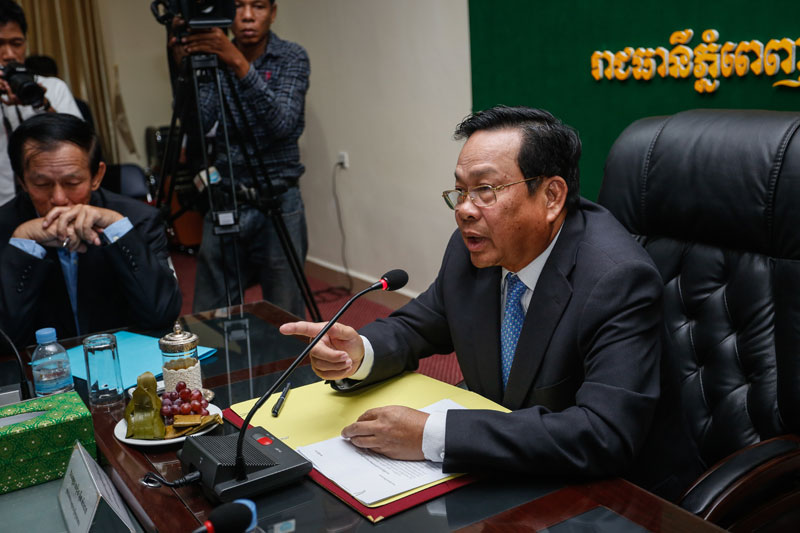The government set the new monthly minimum wage for the country’s multibillion-dollar garment industry at $140 Thursday—up from $128—after months of tough negotiations that failed to bring employers and unions even close to a consensus.
The decision follows a $28 raise to the minimum wage in January and came after a morning vote by the Labor Advisory Committee (LAC) for $135, a figure that Prime Minister Hun Sen promptly bumped up to $140.

“Today we decided on $135,” Labor Minister Ith Sam Heng told reporters. “This is a reasonable number, although we could not meet the requests of each party. The unions are unhappy and employers complained while other parties said it was unreasonable.
“But we have no choice because our increase was based on seven factors,” he said. “In addition to the $135, the prime minister added $5 more, so the minimum wage for 2016 will be $140.”
The new wage takes effect on January 1.
In the midst of the negotiations, factory owners had warned that a raise higher than the current inflation rate of about 3.5 percent would devastate the garment industry, one of the main drivers of Cambodia’s economy. The industry employs some 700,000 people, makes up 80 percent of the country’s export earnings and accounts for a third of the country’s gross domestic product.
But the labor minister sought to assure employers that an extra $12, which raises the current minimum wage by more than 9 percent, would keep Cambodia competitive with its main rivals.
“This [raise] is the result of scientific study and I believe there will be no impact for the investors,” Mr. Sam Heng said. “$140, compared with some of our neighboring countries, makes us higher, so there could be some competitiveness issues. But we have our strong points to attract investors.”
Those strengths, the minister argued, included the peace of mind investors will have knowing that the people making clothes for them are earning a decent wage.
According to the latest data from the International Labor Organization (ILO) on minimum wages in Asia’s main garment exporters, Cambodia still ranks near the bottom at $140, well above Bangladesh and Sri Lanka but roughly on par with Vietnam, where the minimum wage ranges from $100 to $146 depending on the region. Indonesia, Malaysia, the Philippines and Thailand are higher still.
Heading into Thursday’s meeting of the LAC—comprised of 14 government representatives and seven each from the factories and unions—the factories refused to go any higher than $133. But when it came time for the committee to vote, all of their representatives cast their ballots for the government’s proposal of $135, which won all but four of the votes.
“The employers’ seven representatives on the LAC supported it because the government, with the support of the ILO, studied the number carefully, so we can accept it,” said Nang Sothy, one of the seven factory representatives.
Ken Loo, secretary-general of the Garment Manufacturers Association in Cambodia, which represents all exporting garment factories, said employers would pay their workers the $140 the prime minister bumped the wage up to.
But unless worker productivity increases and buyers start paying more for their orders, he said, “there’s only one solution, which is factories have to close, so it’s not whether we are happy or not happy.”
Mr. Loo said some factories unable to cope with the last raise had closed already, and warned that they were “just the tip of the iceberg” if current trends continued.
“We don’t hope for it to happen,” he said. “Maybe productivity will increase and buyers will pay more and factories don’t have to close, but we don’t expect it.”
The latest government data shows that export growth is slowing, but still strong.
Two of the representatives on the LAC abstained from Thursday’s wage vote. The two independent union leaders on the committee, Ath Thorn and Ken Chhenglang, said they voted for $160.
During the negotiations, Mr. Thorn, who heads the largest independent union in the country, warned of mass strikes if the workers were not happy with the new minimum wage.
After Thursday’s announcement, he declined to say whether $140 was worth striking over and said that several of the unions would meet before deciding how to respond.
“After Pchum Ben, we will announce how we will protest and advocate on this issue; we have not decided yet,” he said.
Most of the independent unions gradually whittled their wage proposal down to $160 during the negotiations after starting out at $207, the median monthly expense of more than 700 garment workers surveyed for a recent study commissioned by labor rights groups. According to the same study, their median monthly take-home pay—including overtime, bonuses, and allowances for food and transportation—was $191.
The survey also found that the vast majority of workers were unhappy with the $128 minimum wage and were expecting the government to settle on a new number between $160 and $180.
The government’s failure to meet workers’ wage demands in December 2013 sparked nationwide strikes and demonstrations that briefly crippled the industry and ended the next month when military police shot into a crowd of protesting workers in Phnom Penh, killing at least five of them.
(Additional reporting by Zsombor Peter)